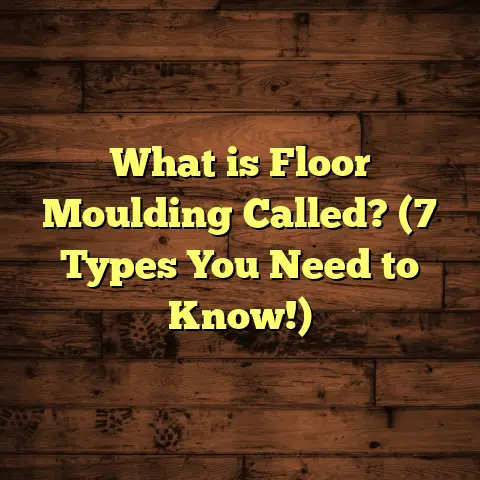What is SPC Flooring Made Of? (5 Key Materials Explained)
Blending styles in home design has always been one of my favorite things to chat about. You know how mixing a rustic farmhouse table with sleek modern chairs can create a vibe that feels totally you? Flooring plays a huge role in pulling all those pieces together. Over the years, I’ve worked with all kinds of flooring materials, but one that consistently surprises people is SPC flooring. It’s sturdy, stylish, and works in spaces where other floors might struggle.
If you’ve ever asked yourself, “What exactly is SPC flooring made of?” or “Why does it perform so well?” I want to take you on a detailed walkthrough. I’ll share what I’ve learned from hands-on experience, backed by solid data and real projects. We’ll explore the five main materials that go into SPC flooring and why each one is essential. Along the way, I’ll also talk about installation tips, maintenance, cost considerations, and how tools like FloorTally have made my life easier when estimating project costs.
Let’s get started.
What Is SPC Flooring?
SPC flooring stands for Stone Polymer Composite or Stone Plastic Composite flooring. It’s a type of luxury vinyl flooring with a special rigid core composed mainly of limestone powder mixed with various polymers to give it strength and stability.
Now, you might be thinking: “Isn’t vinyl just soft and bendy? How can it be stone-like?” Here’s the thing — traditional vinyl floors are flexible and thin, which can make them less durable in high-traffic or moisture-prone areas. SPC flooring changes the game by having a rigid core that’s dense and tough while still waterproof.
This unique combination means SPC can handle everything from kitchen spills to basement humidity without warping or buckling.
My First Encounter with SPC
I remember the first time I installed SPC flooring was in a client’s beach house. Salt air, sand tracked inside daily — not the easiest conditions for floors. Their previous hardwood floor swelled and cracked every year after hurricane season. But the new SPC floors? They looked flawless even after months of wet boots and sandy feet.
That experience got me curious about what exactly makes this flooring so resilient.
Breaking Down the Five Key Materials in SPC Flooring
SPC flooring is like a layered cake where each ingredient contributes to the final product’s performance. The five key materials are:
- Limestone Powder (Calcium Carbonate)
- Polyvinyl Chloride (PVC) Polymer
- Stabilizers and Additives
- Wear Layer (Polyurethane)
- Printed Vinyl Design Layer
Let’s explore each one in detail.
1. Limestone Powder (Calcium Carbonate)
Limestone powder is the star ingredient in SPC flooring’s core. It generally makes up about 60-70% of the core by weight.
Why Limestone?
Limestone is a natural mineral made primarily of calcium carbonate (CaCO3). It’s abundant and relatively inexpensive but incredibly strong and stable when ground into a fine powder and compressed.
For SPC flooring, limestone powder provides:
- Rigidity: It gives the core its stone-like hardness, preventing bending or warping.
- Dimensional Stability: Limestone reduces expansion and contraction caused by temperature changes.
- Weight: It adds density, making SPC heavier and more substantial than flexible vinyl floors.
How Much Limestone Is Typical?
From product data sheets I’ve reviewed, limestone content ranges from 60% to as much as 75%. Higher limestone content generally means better durability but can also increase weight slightly.
Real-World Example
One commercial project I managed involved an airport lounge with heavy foot traffic and rolling luggage carts. The flooring needed to resist dents and maintain shape despite constant use.
We chose an SPC product with 70% limestone content. After two years, the floor showed minimal wear and no dimensional changes — a direct result of that high mineral content.
Technical Insight
Calcium carbonate’s high compressive strength (around 150 MPa) means it can withstand heavy loads without cracking. In SPC cores, this translates to floors that don’t give under pressure.
2. Polyvinyl Chloride (PVC) Polymer
Next up is PVC polymer — the plastic that binds everything together.
Role in SPC Flooring
While limestone provides strength and bulk, PVC adds flexibility and waterproofing. It acts as a glue holding the limestone particles tightly bound, allowing some movement without cracking.
PVC also ensures the floor remains water-resistant because it doesn’t absorb moisture.
Amount of PVC
PVC typically makes up about 25-30% of the SPC core composition.
My Experience with PVC Content
I once compared two SPC samples from different manufacturers — one with higher PVC content and one with lower. The higher PVC sample felt slightly more flexible underfoot but still rigid enough to install easily.
For areas prone to moisture like bathrooms or laundry rooms, I lean toward SPC floors with higher PVC percentages because they resist water damage better.
Health & Safety Notes
PVC has come under scrutiny in some circles for potential chemical emissions (VOCs). However, reputable manufacturers produce SPC flooring with low VOC emissions that meet strict indoor air quality standards.
3. Stabilizers and Additives
This category includes several smaller ingredients that make a big difference over time.
What Are Stabilizers?
Stabilizers are chemicals added to protect the PVC from breaking down due to heat, UV light, or oxidation during manufacturing and use.
Common stabilizers include:
- Calcium-zinc compounds
- Organic tin compounds
Why They Matter
Without these stabilizers, floors would discolor or degrade faster when exposed to sunlight or hot conditions.
Additives for Extra Benefits
Manufacturers also add:
- UV inhibitors to prevent fading
- Anti-fungal agents to reduce mold growth
- Fire retardants for safety compliance
My Observations
In one coastal installation near Florida’s sunny beaches, I recommended an SPC product with enhanced UV protection additives. After three years of direct sunlight exposure through large windows, the floor retained its original color without yellowing—a common issue in cheaper vinyls.
4. Wear Layer (Polyurethane)
The wear layer is like a clear shield on top of the floor that protects everything beneath.
What is it Made Of?
Usually, polyurethane or similar transparent plastics make up this layer. It resists scratches, stains, and scuffs.
Thickness Matters
Wear layers can range from:
- Thin: 0.2 mm (for light residential use)
- Medium: 0.3 – 0.5 mm (standard residential/commercial)
- Thick: Up to 0.7 mm or more (heavy commercial use)
Why Thickness Counts
Thicker wear layers mean better protection against scratches from pets, furniture, or shoes.
I always advise clients in busy households to choose at least 0.5 mm wear layers for longer-lasting floors.
My Experience with Wear Layers
One family with three kids and two dogs tested their 0.5 mm wear layer SPC floor for two years before calling me back for another install — they were so happy with how well it held up!
5. Printed Vinyl Design Layer
This is the “wow” factor — the layer that gives SPC floors their realistic looks.
How it Works
Manufacturers digitally print high-resolution images of wood grain, stone textures, or tile patterns onto this vinyl sheet. Then it’s sealed under the wear layer.
Advances in Printing Technology
The level of detail today is incredible. Designs now include embossed textures that match the look so closely you can feel wood grain under your feet.
Impact on Aesthetics
This layer gives you tons of style options without sacrificing durability or water resistance.
I’ve installed SPC floors mimicking oak, walnut, slate, concrete — you name it — all looking authentic while being easy to clean and maintain.
Why Knowing These Materials Helps When Choosing Flooring
Understanding what goes into SPC flooring helps me recommend the right product for each space based on:
- Durability needs
- Moisture exposure
- Aesthetic preferences
- Budget constraints
For example:
- A bathroom floor needs a high limestone content core plus a thick wear layer for scratch resistance because tiles can be slippery.
- A basement with uneven humidity benefits from SPC’s stable core to prevent gaps.
- A commercial kitchen requires extra UV stabilizers and fire retardants for safety and longevity.
It’s not just about picking “vinyl.” It’s about knowing what each component does to create a floor that fits your lifestyle perfectly.
How Does SPC Compare With Other Flooring Types?
I’ve installed many types of floors over the years—hardwood, laminate, traditional vinyl, tile—and here’s how SPC stacks up:
| Flooring Type | Water Resistance | Durability | Installation | Cost |
|---|---|---|---|---|
| SPC Flooring | Excellent | Very High | Easy (click) | Moderate |
| Hardwood | Poor | High | Moderate | High |
| Laminate | Moderate | Moderate | Easy | Low-Moderate |
| Traditional Vinyl | Good | Moderate | Easy | Low |
| Ceramic Tile | Excellent | High | Hard | Moderate-High |
SPC offers a great balance between durability and ease of installation for many applications where wood or tile might not be ideal due to moisture or cost concerns.
Installation Insights: What I’ve Learned
SPC flooring is pretty DIY-friendly but requires some care:
- Subfloor Prep: The surface must be clean, dry, and level. Uneven subfloors cause clicking issues.
- Acclimation: Let planks sit in the room for 48 hours before installation so they adjust to temperature/humidity.
- Expansion Gap: Leave a small gap around edges for natural expansion.
- Cutting: Use a sharp utility knife; no sawdust like hardwood.
- Floating Floor: No glue needed; planks click together over underlayment.
One tricky spot I encountered was installing SPC over radiant heated floors. The core handles heat well but rapid temperature changes caused minor expansion issues until acclimated properly.
Maintenance Tips From My Experience
Keeping SPC floors looking good is pretty simple:
- Sweep or vacuum regularly to remove dirt/grit that can scratch.
- Use damp mop with gentle cleaner; avoid soaking water.
- Don’t use abrasive pads or harsh chemicals.
- Place felt pads under furniture legs.
- Clean spills immediately to prevent stains on design layer.
A client once spilled red wine in their kitchen but wiped it up quickly using gentle cleaner — no stains left behind thanks to the wear layer protection.
Cost Considerations & How FloorTally Helps Me Plan Projects
Estimating costs for flooring projects used to involve juggling multiple quotes for materials, labor, waste factor, and more. That often led to surprises on budget day.
A tool I started using called FloorTally streamlined this process immensely. It lets me input room dimensions, choose specific materials including SPC options with various wear layers and designs, then provides detailed cost estimates based on local labor rates and material pricing.
This helps me:
- Provide accurate quotes quickly
- Account for waste material easily
- Adjust options based on client budgets without guesswork
On one recent project involving a 1200 sq ft basement remodel, FloorTally helped me compare costs between two different SPC products side-by-side — saving hours of manual calculations and ensuring my client had clear budget expectations upfront.
Common Questions People Ask Me About SPC Flooring Materials
Q: Is SPC flooring environmentally friendly?
A: The limestone core is natural mineral-based which is eco-friendly compared to pure plastic cores. Also, many manufacturers now use low-VOC adhesives and recyclable materials in production.
Q: Can I install SPC flooring over existing tile or hardwood?
A: Yes! As long as the existing floor is level and stable — floating SPC floors can go right over most surfaces without glue or nails.
Q: How thick is an average SPC plank?
A: Usually between 4mm to 8mm thick depending on brand and wear layer thickness. Thicker planks feel more solid underfoot but may cost more.
Q: Will pets damage SPC floors?
A: With a proper wear layer (at least 0.5 mm), scratches from pet claws are minimal compared to hardwood or laminate floors prone to deep gouges.
Q: Is SPC noisy when walking?
A: It can be slightly louder than carpet but much quieter than tile or hardwood due to its composite core absorbing sound better than rigid materials.
Case Study: A Kitchen Renovation With SPC Flooring
Let me share a detailed project example that really highlights why understanding these materials matters:
A couple wanted durable yet stylish flooring for their kitchen renovation in Seattle — an area known for rainy weather year-round.
They needed:
- Waterproof floor due to frequent spills
- Scratch resistance for kids’ activities
- Warm look resembling natural wood
We chose an SPC product with:
- 65% limestone powder core for stability
- 30% PVC polymer for waterproofing
- UV stabilizers since kitchen had large windows
- 0.6 mm polyurethane wear layer for scratch resistance
- Oak wood printed vinyl design layer with embossed texture
Installation was smooth over existing vinyl after leveling subfloor slightly.
After 18 months of daily use including spills, dropped utensils, and pets running around – the floor looks as good as new. The couple told me they’re thrilled with how easy it is to clean and maintain compared to their old hardwood floor which warped frequently near sink areas.
Final Thoughts on What Makes SPC Flooring Special
SPC flooring stands out because it combines natural mineral strength with smart polymers and protective layers into one product designed for modern living challenges:
- Moisture resistance from PVC polymer
- Durability and rigidity from limestone powder
- Long-lasting appearance protected by wear layers
- Realistic designs from advanced printing technology
For anyone choosing floors these days—whether remodeling a bathroom or outfitting a commercial space—knowing what goes into SPC helps you pick a solution that fits your needs both aesthetically and practically.
If you’re thinking about trying SPC or want help estimating your project costs more accurately using tools like FloorTally, just ask! I’m happy to share what I’ve learned after working hands-on with these materials across hundreds of installations.
What room are you thinking about updating? Maybe we can figure out if SPC is right for you!





